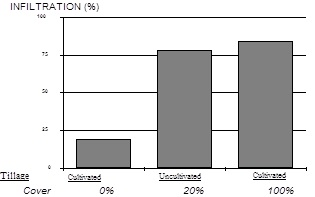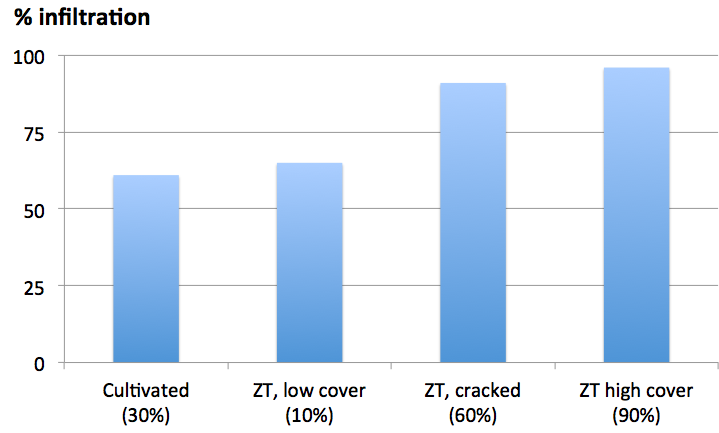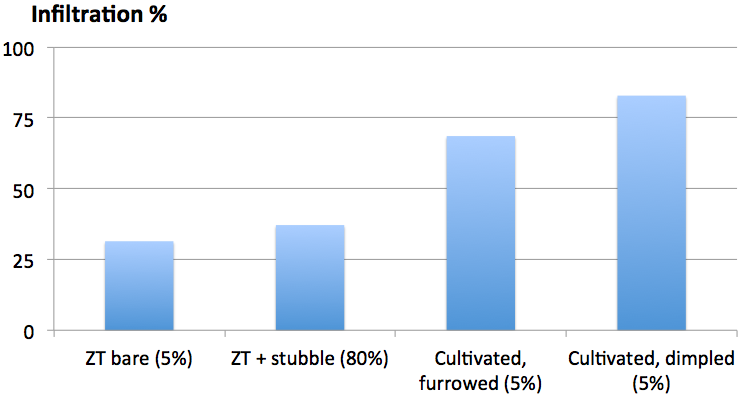Improving fallow efficiency
Author: David Freebairn, University of Southern Queensland | Date: 23 Feb 2016
Take home message
- While ~20% of rain is stored during fallows, small changes in soil management can improve this apparent low efficiency and have large impacts on profit.
- Water stored can be improved through longer fallow, weed control, soil cover and reduced compaction. This can be achieved through reduced tillage, controlled traffic and planting crops before the soil fills.
- Stubble retention combined with reduced or zero tillage almost universally results in better water storage.
- Better water storage results in better yields, especially in dry years.
- Soil water and N mineralisation can be tracked using a number of decision support tools (e.g. Australian CliMate, Soil Water App, Yield Prophet).
Getting water into the soil
Storing soil water is a challenge in our environment where evaporation potential is higher than rainfall in all months. Typically, we have 2-3 times the evaporation potential compared to rainfall. High clay content soils, which hold so much water in the surface, make the value of small falls of rain less useful than we might hope for. High intensity rainfall, a feature of summer rainfall in the northern grain region, can result in valuable water being lost as runoff and resultant erosion.
The starting point for improving rainfall capture is to minimise runoff. Soil cover is a crucial factor determining infiltration (Table 1). Cover, either as crop residue or a crop canopy, reduces surface sealing. A puddled crust of 1-2 mm thickness is enough to slow infiltration. On average, a soil cover greater than 40 per cent over the summer can reduce annual runoff by 15-30mm compared to bare fallows.
Table 1. Influence of tillage and soil cover on runoff and water storage on a grey brigalow clay (Greenwood 1978-83).
|
Tillage management |
Bare fallow |
Disc tillage |
Blade tillage |
Min/no till |
|
Fallow efficiency (%) |
21 |
25 |
26 |
32 |
|
Range of FE |
9-29 |
8-38 |
17-36 |
12-32 |
|
Reduced runoff (mm) |
- |
24 |
32 |
15 |
|
Extra soil water (mm) |
- |
13 |
16 |
36 |
Soil cracks also offer a pathway for rapid uptake of rainfall, with intense storms putting some water at depth through cracks, out of evaporations harm’s way. Avoid cultivation if soil cover is low and soil is cracked (Figure 1).

Figure 1. Infiltration of simulated rainfall (40 mm at 100 mm h-1) on a brown clay near Wallumbilla where the soil was cultivated with no soil cover after cultivation, left uncultivated with low cover and cracks, or cultivated with good cover.
Soil water content (How wet?) is important in determining the rate of infiltration. When a soil is full, further rain will either runoff or evaporate. Crop sequences need to be flexible to capitalise on wetter than average conditions and likewise be prudent when soil water is low. As a general rule, fallows longer than one summer are wasteful in terms of storing water. If the soil profile is greater than 50-75 per cent full, planting another crop should be considered.
Keeping it in?
Once rainfall is captured in the soil, the next major challenge is to keep it there for crop use. This is not as easy as it might first seem. During fallows, an average of 65 per cent of rainfall is lost as evaporation - this high loss is largely a result of the high water holding capacity of our clay soils, infrequent rainfall and high evaporation conditions. Many small falls of rain are 'captured' in the top 10 cm, only to be lost to evaporation before the next rainfall.
Stubble can reduce evaporation by increasing the reflectance of the soil surface and reducing the velocity of air movement at the soil surface, but these differences are not long lived. If it stays dry for a few weeks, any gains associated with stubble can be lost. Surface cover and good soil structure allow water to move below the “hot” zone where it will be relatively safe from evaporation “pull”. Improvements in water storage have mostly been explained by reductions in runoff losses although evaporation reduction can be important in extending planting dates.
Weeds can be a serious cause of water loss within a crop and fallow - up to 5 mm/day. It is essential that weeds be controlled while they are small to avoid use of soil water and seed setting.
Money in the bank?
Extra water safely stored in the soil through best management can be worth up to 500 kg/ha, especially in dry years. Figure 2 shows a comparison of grain yields from all tillage trails in southern and central Queensland over a 30-year period. Minimum/no-tillage results in superior yields except in wetter years. In order to make use of available water, nutrition and disease management are equally important, with good rotations a key part of the better water management game. It would be fair to say that farmers have got better at agronomy (compared to researchers) with time than the results in Figure 2 suggest.

Figure 2. Comparison of grain yields from 120 experiment years from tillage trails in southern and central Queensland in the 1970’s to 2007 (Thomas et. al 2007).
Soils are different
While it seems obvious, soils vary greatly, even in the one paddock, so are there any general rules? Much is talked about regarding tillage or no-tillage. Recent research by Dang et al (2014) has shown that an occasional tillage does not appear to undo hard-won gains in soil structure. Some common principles can be summarised as:
- soil cover from stubble or crops is good, and generally the more the better;
- when no soil cover occurs, tillage may be the best option;
- water storage and use is best when crops are growing – provide cover and keep soil drier;
- compaction can only be a bad thing for roots and infiltration; and
- weeds will always be robbers of moisture and nutrients, but may be tolerated at times if small and don’t seed.
But each soil needs to be managed differently, and good observation with contrasting management is the best way to learn about your soil. For example, the following observations from a simple rainfall simulation demonstration raised many questions and much discussion (Figure 3).


Figure 3. Infiltration of simulated rain on two soil types: a Brigalow-belah clay near Wallumbilla (left) and a red brown earth near Goondiwindi (right) (Cawley et. al 1992).
An example fallow decision pathway
A possible decision pathway for deciding what tillage strategy to follow after harvest.
How long to fallow?
If good rain occurred before harvest, and the soil profile is greater than 3/4 full, extending a fallow is a waste of time, water and money. Remember that on average, only one mm in every 4-5 mm of rain (20-25 per cent) is stored in the soil. Push probes, soil cores and SoilWaterApp should be sueful here.
Are weeds a problem?
If no, best option is to do nothing. If weed control is necessary, either spray, or cultivate to maximise stubble cover.
Is soil cracked?
- If yes, cracks indicate moisture is gone. Do not cultivate until cracks close.
- Once cracks are closed, either a) maintain stubble cover or b) if little cover, create a rough surface
- Roughness can be created with tillage, but don’t use harrows. Extra cover (stubble) cannot be created after harvest so look after it.
What happens if no stubble is available?
Once cracks are closed, tillage is needed to maintained roughness and break crusts. Hard setting soils especially need tillage and roughness (some of these soils may need a pasture phase to improve soil structure).
What happens if the soil is fine and no stubble is available?
An unenviable position - hope for gentle rain and plant a crop as soon as possible.
References
Cawley ST, Hamilton NA, Freebairn DM, Markey LJ, Wockner GH. 1992. Evaluating fallow management options by using rainfall simulation - action learning approach with farmers. QDPI Proj. Rept. SQA 91012. 27 pp.
Dang YP, Seymour NP, Walker SR, Bell MJ, Freebairn DM. 2015. Strategic tillage in no-till farming systems in Australia’s northern grains-growing regions: I. Drivers and implementation, Soil Tillage Res.
Thomas GA, Titmarsh GW, Freebairn DM, Radford BJ. 2007. No-tillage and conservation farming practices in grain growing areas of Queensland –a review of 40 years of development. Aust. J. Experimental Agric. 47:887-898.
Acknowledgements
The research undertaken as part of this project is made possible by the significant contributions of growers through both trial cooperation and the support of the GRDC, the author would like to thank them for their continued support.
Contact details
David Freebairn
Ph: 0408 876 904
Email: david.freebairn@usq.edu.au
GRDC Project Code: USQ00014,
Was this page helpful?
YOUR FEEDBACK
